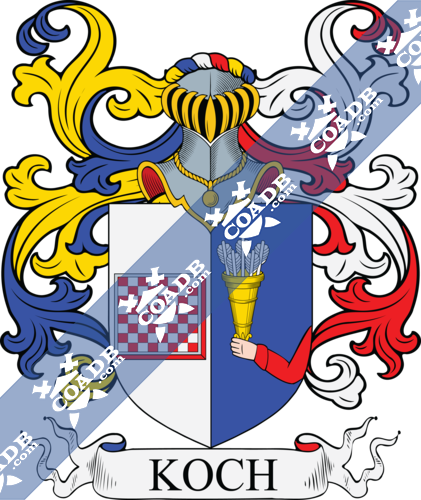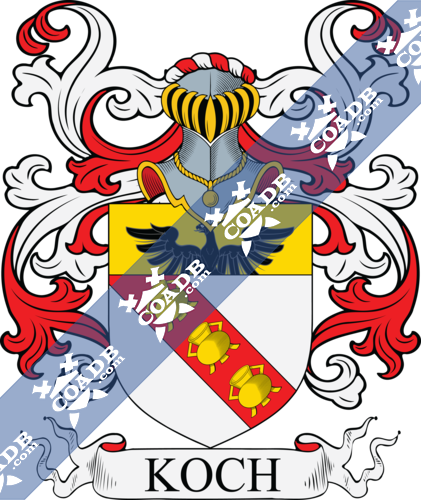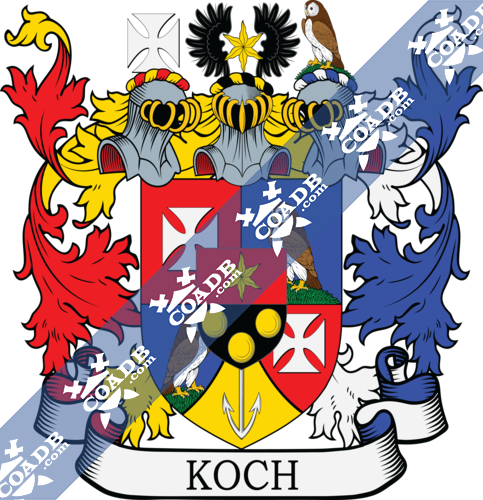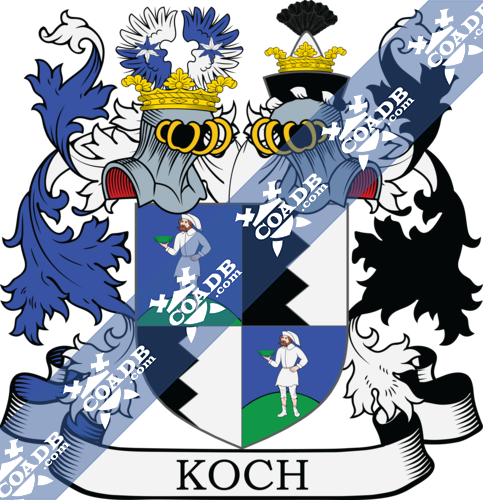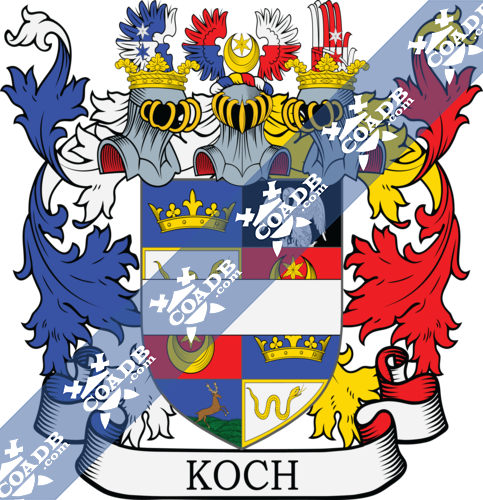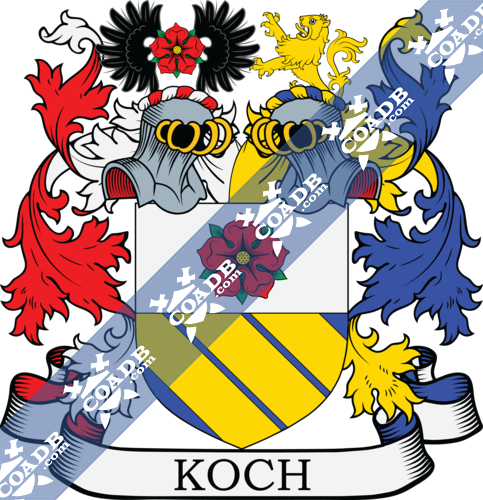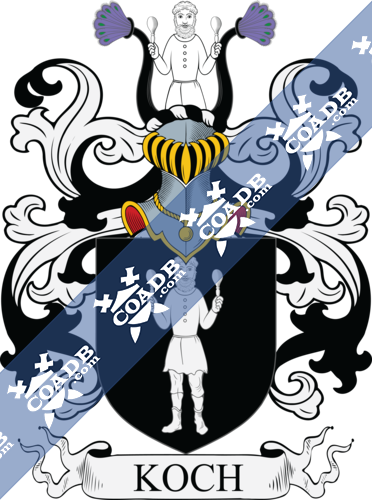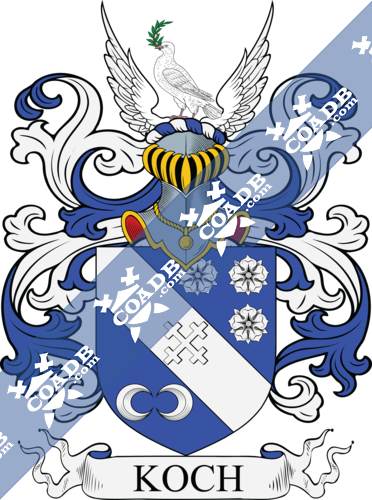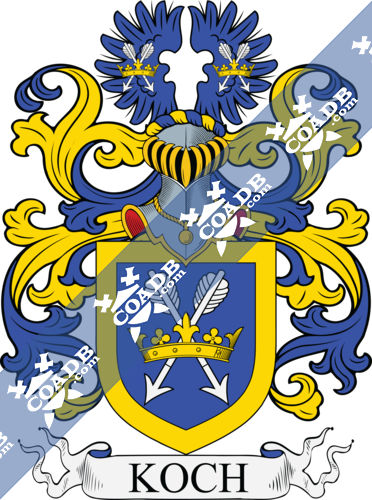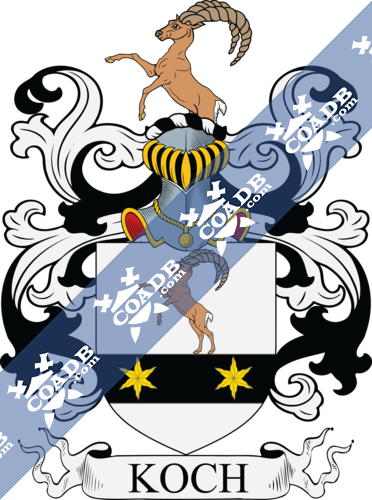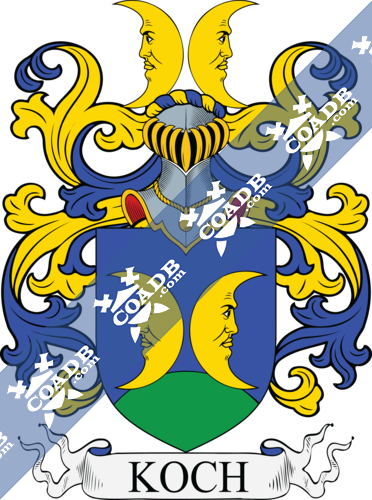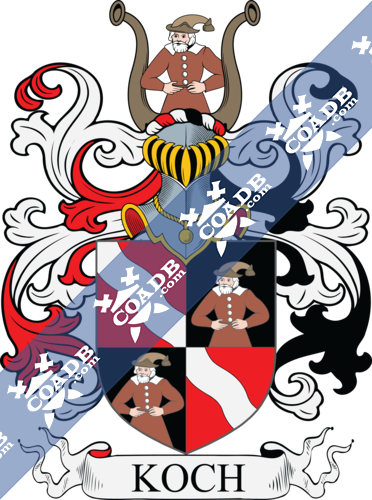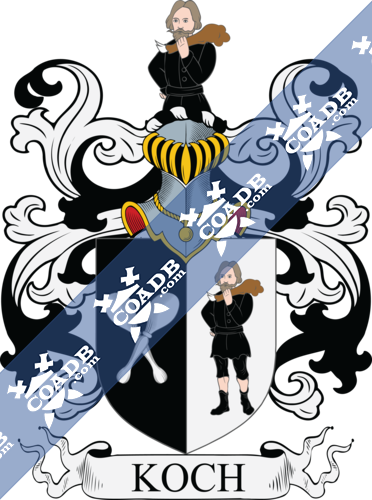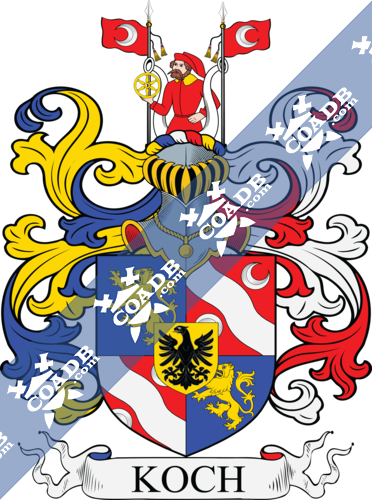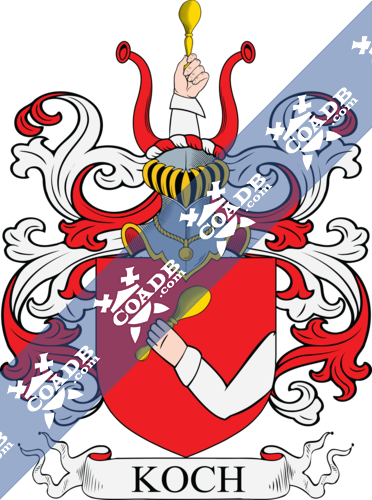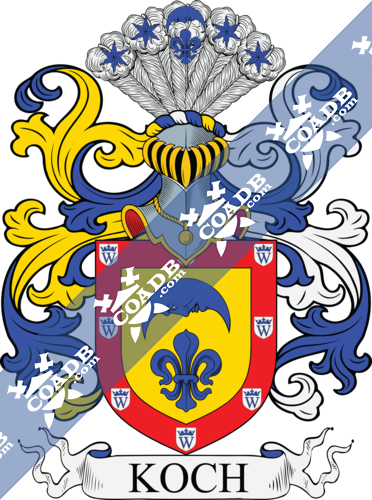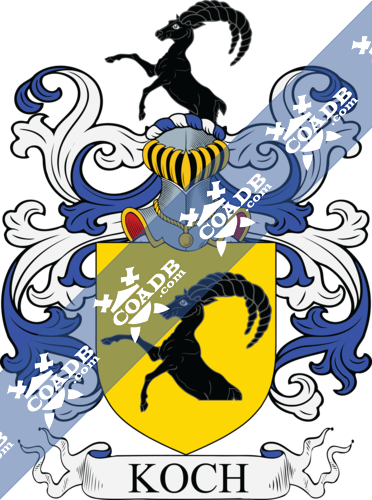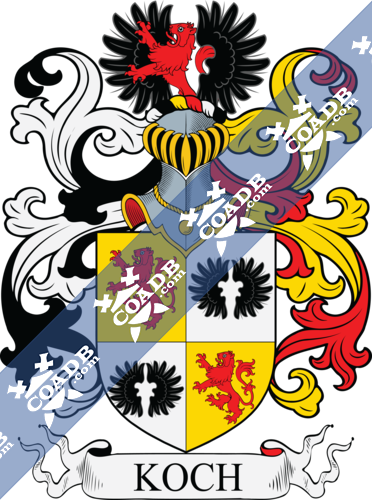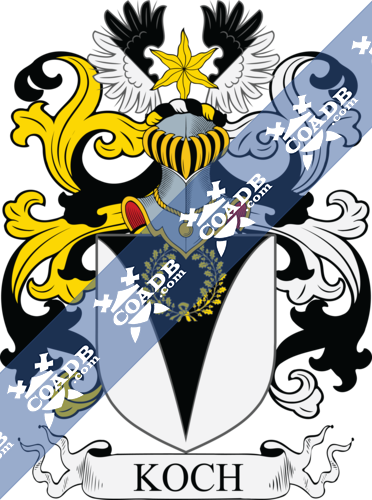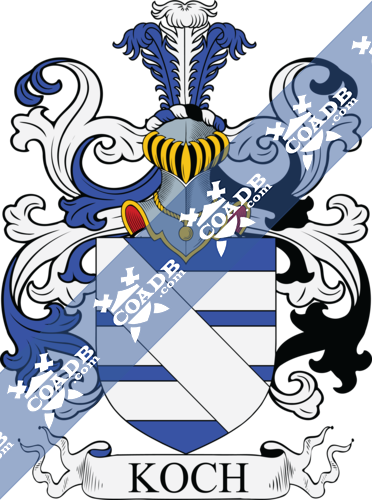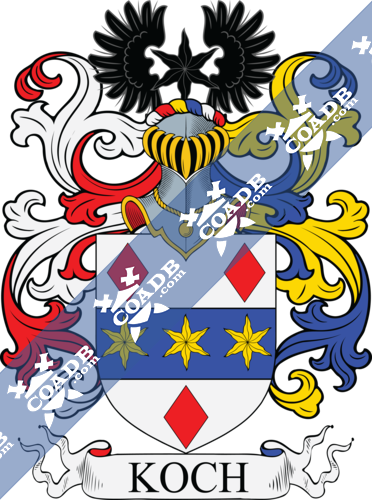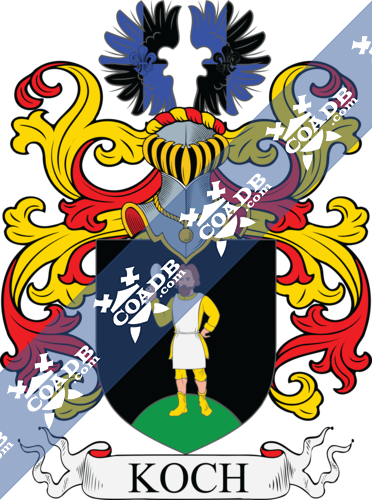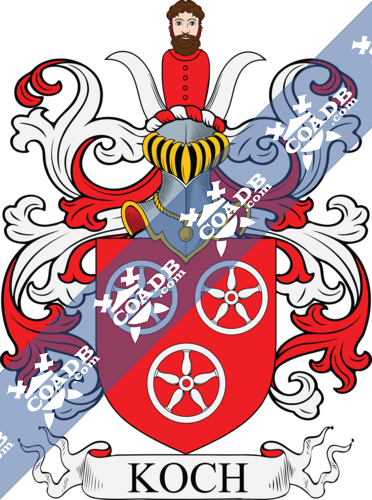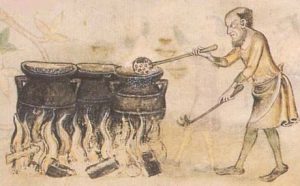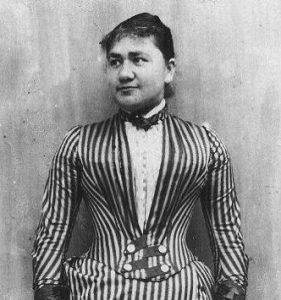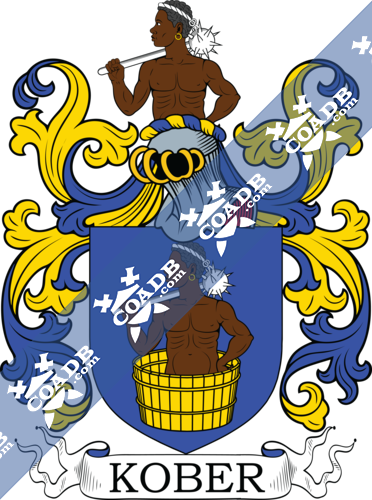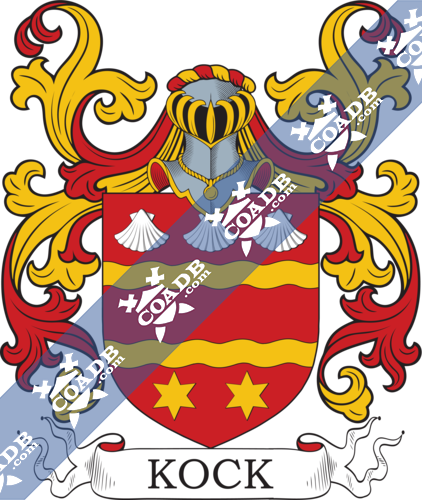Koch Family Crest, Coat of Arms and Name History
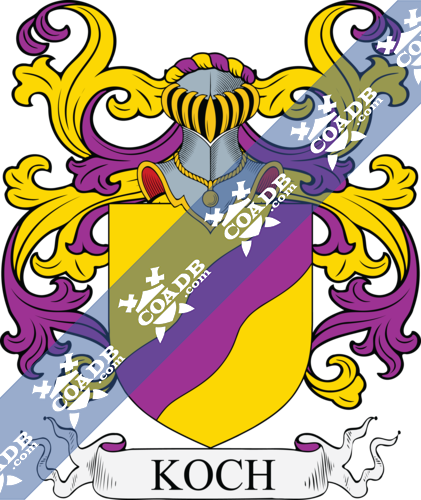
Koch Coat of Arms Gallery
Don’t know which Coat of Arms is yours?
We can do a genealogical research. Find out the exact history of your family!
Learn MoreSurname Name Meaning, Origin, and Etymology
Koch is a German (or Jewish) occupational last name for a cook, a person who prepared food, or a title for a person in charge of a kitchen (for a Lord or Baron or other royal/noble house or a monastery), deriving from the Latin word coquess or coquus and the Middle High German koch, meaning cook. Often times, a village would have a cook who made food collectively for the inhabitants, since not all houses were outfitted with the proper equipment, which was likely too expensive and limited in quantity for each individual house to hold. Hence, it was a vital job in the Middle Ages and prior, as attested by its frequency throughout the continent. One source claims the surname was first found in Bavaria, which was part of the Holy Roman Empire, during medieval times, and became popular throughout Christendom.
There are also two other origins theories or meaning for the Koch surname. First, it could be a Slovak or Czech name deriving from a per form or reduced version of medieval personal (first) names beginning with Ko (ex. Kocian, Kojata, Kosmas, and Kochan). Second, it could be Polish in origin and derive from the nickname from the word kochac, meaning “to love”, and hence has a similar etymology as the Polish surname Kochan.
Spelling Variations
Common spelling variants or names with similar etymologies include Koche, Koech, Kochen,Cook, Kosh, Kotch, Coke, Caulk, Koeche, Coch, Coche, Coech, Cochen, Coeche, Coechekn, Kock, Kochs, Kocks, Koechli, Koehchle, Koechly, Kooch, Koock (Lower German), Kockly (Swiss), Kox (Lower Rhine), and Keoch.
Popularity & Geographic Distribution
This surname is popular through mainland Europe, but is somewhat uncommon in the British Isles. The Koch last name ranks as follows in the following countries: Germany (13th), Austria (42nd), Switzerland (34th), France (824th), South African (553rd), Netherlands (554th), Denmark (92nd), Sweden (796th), Belgium (1,273rd), Hungary (726th), Norway (973rd), Luxembourg (64th), Estonia (455th), Canada (1,296th), Australia (1,066th), and New Zealand (3,324th).
The last name Koch ranks 657th in popularity in terms in the United Status as of the 2000 Census. The name ranks particularly high in the following ten states: Wisconsin, Minnesota, Iowa, Nebraska, South Dakota, North Dakota, Montana, Kansas, Missouri, and Pennsylvania.
Early Bearers of the Surname
The earliest known bearer of this surname was Burchart Coch who was documented in the city of Zurich in 1224 AD. Hainricus Coci was recorded in Hohentangen, German in 1268 AD. Rufolf Kocheli was documented in Konstantz in 1303 AD. Henne Koclin was recorded in Wurzburg in 1409 AD.
History, Genealogy, Ancestry & Pedigree
Nikolaus Koch was born in Eberbach, Germany in 1515. He had a son named Niklas. Niklas was born in the same town in Baden-Wuerttemberg in 1545. He married Barbara and had two issue with her: Nicholaus and Michel. The former son was born in Eberbach in 1580 and he married a woman named Anna. They had a son named Nickel born in 1610. This Nickel married Maria Baspach and later Anna Katherina Husskor and he had two children: Martha Maria and Hans Michael. His son Hans Michael Koch was born in Oberdielbach, Neckar-Odenwald-Kreis in 1648 and he married Anna Maria Schultheiss with whom he had a son named Johann. This Johann Georg Koch was born in Eberbach in 1680. He married Marie Barbara Waesch and had a son with her whose name was also Johann. This Johann Adan Koch was born in 1717 in Laudenbach, Bavaria. He married Anna Susanne Breidenbach and had a son with her named Johann Adam. This Johann Adam was born in Laundenbach on the Main in 1745. He married Maria Anna Winkler and had a son with her named Franz. This Franz Stephen Koch was born in 1789 in Bavaria. He married Maria Josepha Breitenbach and had a son with her. This son was Johann Adam Breitenbach Koch who was born in the same town in 1822. He went to St. Louis, Missouri where he married Agnes Schneider. They had a son together named Joseph. Joseph Koch was born in Germany in 1846 and he married Barba Buhl. They had a son together also named Joseph. This Joseph Koch was born in Quincy, Illinois in 1882 and he married Calara M. Bessling Ohnemus. Prior to his death in 1905, he had a daughter named Agnes Clara.
Johann Conrad Kock was born in 1762. He married Etta Maria Harms. They had a son named Johann Anthon Koch who was born in Jever, Lower Saxony, Germany in 1790. He married Anna Sophia Schols and had the following issue with her: Jurjen, Johann Conrad, Lolkje, Etta Maria, Etta Marie, Johanna Meyer, Johan Anthon, Mietje, and Jeane. His son Johann Anthon was born in Workum, Friesland, Netherlands in 1836. He had numerous issue, including a son named Hotze (Harry) Koch who was born in the Netherlands and went to Texas, United States. He married Margaret B. Mixson and had two issue with her: John Anton and Fred Chase. Fred Chase Koch was born in 1900 in Quanah and was the father of the famous Koch brothers.
Michael “Nickell” Koch was born in 1706 in Bosenbach, Zweibrucken, Paltinate, Germany. He came to Pennsylvania He had a son named Philip. Philip who was born in British Colonial America around 1756. He married Elizabeth Ripple and had a son with her named William. William Koch was born in Northampton, PA in 1778 and he married Barbra Derr. They had a son together named Enos Washington who was born in the same town in 1819. He married Christina Chrisman and had a daughter with her named Elenora, born in 1869, who married Jesiah Muffley, and had a son with him, prior to hear death in 1924.
Joel Koch was born before 1887. He had a son named Juda Isak who married Clara Edelstein. They had a son named Louis who was born in Ustecko, Ukraine in 1894. He married Yetta Joyce Silpe and came to the United States. They had several children, including Edward Irving Koch, born in 1924 who became the 105th Mayor of New York City in 1977. He was born in the Bronx and was of Jewish ancestry.
Early American and New World Settlers
Early settlers in colonial America bearing this name include: Anna Maria Koch (New York City 1709), Johann Koch (1709), Georg Ludwig Koch (New York City 1710), Jacob Koch (North Carolina 1722), and Caspar Koch (Carolina 1738).
Early Americans Bearing the Koch Family Crest
I researched the following three resources and did not find any coats of arms for Koch: Bolton’s American Armory, Matthew’s American Armoury and Bluebook, and Crozier’s General Armory.
Mottoes
We have identified one Koch family motto: Candidor Illis, meaning “Bright days” or “Purer than the others” or “Brighter than those others”.
Grantees
We have 27 coats of arms for the Koch surname depicted here. These 32 are from Armorial General published in 1861 by the famous genealogist/heraldist Johannes Baptisa Rietstap. The bottom of this page contains the blazons (in French and English), and in many instances contains some historical, geographical, and genealogical about where coat of arms was found and who bore it.
Notables
There are hundreds of notable people with the Koch surname. This page will mention a handful. Famous people with this last name include: 1) Charles de Ganahl Koch and David Hamilton Hoch, born in 1935 and 1940, respectively, are American businessman born in Wichita, Kansas, known as the Koch Brothers, who own a family business called Koch Industries, a conglomerate that is the second largest private firm in the United States, who was well-known for their monetary contributions and activism in libertarian and conservative causes and organizations, 2) Amy T. Koch (1971) who was born in Buffalo, Minnesota, a Republican who became the Minnesota State Majority Leader, 3) Berthold Koch (1899-1988) who was a German chess master and journalist from Berlin, 4) Carl Koch (1912-1998) who was an American architect born in Milwaukee, Wisconsin who was associated with the design of prefabricated homes and pioneering the Techcrete building systems, 5) Albert Aubrey Koch (1904-1975) who was an Australian military and civil pilot born in Ulverstone, Tasmania who served in World War II who earned fame as the rescuer of the Archbold expedition,6) William Koch (1974) who was a relief pitcher in MLB who was born in Rockville Centre, New York and played for the Toronto Blue Jays, Chicago White Sox, Oakland Athletics, and Florida Marlins, 7) Carl Ludwig Koch (1778-1857) who was an German arachnologist and entomologist born in the city of Kusel, 8) Wilhelmina Amalie Koch (1845-1924) who was a German composer of holy and secular song melodies and biblical motets and was only one of two women whose work was included in the Protestant hymnal, 9) Ursula Koch (141) who was the first women president of the Social Democratic Party of Switzerland and was from the city of Zurich, 10) Stephan W. Koch (1953) who is a German theoretical physicist born in Frankfurt who is a professor at the University of Marburg who is best known for his contributions to the gelds of optical/electronic properties of semiconductors, lasers, and quantum optics, 11) Pyke Kock (1901-1991) who was a Dutch artist known for painting in the magic realist school, and 12) Pauline Koch (1858-1920) who was the mother of Albert Einstein and was born in Cannstatt in the Kingdom of Wurttemberg.
Blazons & Genealogy Notes
1) Nuremberg, Memmingen – De sable à un homme habillé d’une tunique d’argent tenant de chaque main une cuiller d’argent Cimier l’homme issant entre deux proboscides de sable ornées chacune dans son embouchure de plumes de paon au naturel; English: Sable with a man dressed in a tunic argent, holding in each hand a spoon argent; Crest: the man issuant between two proboscides sable, decorated each in its mouthpiece with peacock feathers proper.
2) P. de Vaud – Orig. de Bade – D’or à la barre ondée de pourpre English: Or with a bend sinister undy purpure.
3) Mecklembourg – (An., 24 janv. 1845) – De sable à une couronne de chêne d’or liée d’un ruban flottant du même le champ chaussé-ployé d’argent Casque couronné Cimier une étoile d’or entre un vol l’aile dextre tranchée et la senestre taillée de sable sur argent Lambrequin à dextre d’or et de sable à senestre d’argent et de sable English: Sable with a crown of oak or, tied [banded] with a ribbon flying of the same, the field chausse ploye [division curved from middle base to dex & sin top] argent; Crowned with a helmet – Crest: an estoile or between a pair of wings, the wing dexter – per bend, and the sinister per bend sinister sable over argent; Mantling: to the dexter or and sable, to the sinister argent and sable.
4) Edle von Teublitz – Oldenbourg – (Nob. du St-Empire, 27 nov. 1769, et 1777) – Coupé au 1 d’argent à une rose de gueules boutonnée d’or barbée de sinople au 2 d’azur à trois bandes d’or Deux casques couronnés Cimiers 1° la rose du 1 entre un vol de sable Lambrequin d’argent et de gueules 2° un lion issant d’or Lambrequin d’or et d’azur English:Per fess – 1st argent with a rose gules, budded or, barbed vert; 2nd azure three bends or; Crowned with two helments – Crests: 1st the rose of the 1st between a pair of wings sable; Mantling: argent and gules; 2nd a lion issuant or; Mantling: or and azure.
5) Mecklembourg – (An., 17 nov. 1845) – D’azur à trois fasces d’argent à la bande du même brochant sur le tout Casque couronné Cimier trois plumes d’autruche une d’argent entre deux d’azur ou une d’argent entre deux de sable Lambrequin d’azur d’argent et de sable English: Azure three bars argent, a bend of the same covering overall Crowned with a helmet – Crest: three ostrich feathers – one argent between two azure ((alternatively) one argent between two sable) Mantling: azure, argent and sable.
6) Prov. rhénanes – (Nob. du St-Empire, 26 mai 1737) – D’argent à la fasce d’azur ch de trois étoiles d’or et acc de trois losanges de gueules Casque couronné Cimier une étoile entre un vol de sable Lambrequin à dextre d’argent et de gueules à senestre d’or et d’azur English: Argent a fess azure, charged with three etoiles or and accompanied by three lozenges gules; Crowned with a helmet – Crest: an estoile between a pair of wings sable; Mantling: to the dexter argent and gules, to the sinister or and azure.
7) Wurtemberg – (Barons, 23 oct. 1812) – De sable à un homme habillé d’or au tablier d’argent posé sur un tertre de sinople tenant de sa main dextre une cuiller d’argent la senestre appuyée sur sa hanche Casque couronné Cimier un vol chaque aile écartelée d’azur et de sable l’aile dextre ch d’une fleur-de-lis d’azur et l’aile senestre ch d’une fleur-de-lis de sable brochant sur l’écartelé Lambrequin d’or et de gueules English: Sable with a man dressed or, with an apron argent, placed on a hillock vert and holding in his dexter hand a spoon argent, the sinister resting on his hip; Crowned with a helmet – Crest: a pair of wings, each wing quarterly azure and sable, the wing dexter charged with a fleur de lys azure, and the wing sinister charged with a fleur de lys sable, both covering over the quarterly; Mantling: or and gules.
8) Vienne – (Nob. du St-Empire, 9 janv. 1740) – D’argent à la bande de gueules ch de trois marmites d’or au chef du même ch d’une aigle éployée issante de sable English: Argent a bend gules charged with three cooking pots [2 handles 3 feet] or, a chief of the same charged with an eagle displayed issuant sable.
9) Souabe – De gueules à trois roues de cinq rayons d’argent Cimier un buste d’homme habillé de gueules entre deux cornes de buffle d’argent English: Gules three wheels with five spokes argent; Crest: a bust of a man, dressed gules, between two buffalo horns argent.
10) Suède – (An., nov. 1803) – D’azur à la bande d’argent ch d’une croisette de et acc en chef de trois roses d’argent et en pointe de deux croissants affrontés de Cimier une colombe tenant en son bec un rameau d’olivier entre un vol English: Azure a bend argent, charged with a crosslet, accompanied by in chief of three roses argent, and in base of two crescents affrontant [face to face]; Crest: a dove holding in its beak an olive branch between a pair of wings.
11) Bâle, Berne – D’azur à deux flèches d’argent passées en sautoir dans une couronne d’or à la bordure du même Cimier un vol chaque aile aux armes de l’écu (ou un vol à l’antique d’or et d’azur) English: Azure two arrows argent, placed saltirewise inside a crown or, a bordure of the same; Crest: a pair of wings, each wing charged with the arms from the shield ((alternatively) a pair of ancient wings or and azure).
12) Bavière – D’argent à une fasce abaissée de sable ch de deux étoiles (6) renversées d’or et soutenant un bouquetin saillant au naturel Cimier le bouquetin issant Lambrequin d’argent et de sable English: Argent with a fess abased [lower than normal] sable, charged with two etoiles of 6 points reversed or, and supporting an ibex saillant [leaping forward] proper; Crest: the ibex issuant; Mantling: argent and sable.
13) Bâle – D’azur à deux croissants figurés adossés d’or soutenus d’un tertre de sinople Cimier les croissants English: Azure two crescents figured [with a face] addorsed [back to back] or, standing on a hillock vert; Crest: the crescents.
14) (Barons) – Autriche – Écartelé aux 1 et 4 de gueules à la croix pattée alésée d’argent aux 2 et 3 d’azur à une chouette de profil au naturel posée sur une terrasse de sinople la chouette du 3 contournée Enté en pointe d’or à une ancre d’argent Sur le tout coupé a de gueules à une étoile d’or b de sable à trois besants d’or Trois casques couronnés Cimiers 1° la croix Lambrequin d’or et de gueules 2° l’étoile entre un vol de sable Lambrequin d’or et de sable 3° les meubles du 2 Lambrequin d’argent et d’azur English: Quarterly: 1st and 4th gules with a cross pattee argent; 2nd and 3rd azure with an owl in profile proper, placed on a mount vert, the owl of the 3rd reversed; in mantle in base or with an anchor argent; on an escutcheon per fess a) gules with an estoile or; b) sable three bezants or; Crowned with three helmets – Crests: 1st the cross; Mantling: or and gules; 2nd the etsoile, between a pair of wings sable; Mantling: or and sable; 3rd the charges of the 2nd quarter; Mantling: argent and azure.
15) Allemagne – Écartelé aux 1 et 4 de gueules à la bande ondée d’argent aux 2 et 3 de sable à un homme issant Cimier l’homme entre deux proboscides English: Quarterly: 1st and 4th gules a bend undy argent; 2nd and 3rd sable with a man issuant; Crest: the man between two proboscides.
16) Bavière – (An., 9 sept. 1769) – Écartelé aux 1 et 4 d’argent à deux fasces d’azur aux 2 et 3 d’azur à une rose d’argent Cimier sept plumes d’autruche alternativement d’argent et d’azur (Barons 23 nov 1790) Écartelé aux 1 et 4 d’or à deux fasces d’azur aux 2 et 3 de gueules à une rose d’argent Casque couronné Cimier huit plumes d’autruche disposées sur deux rangs le premier rang alternant d’argent et de gueules et le second rang alternant d’or et d’azur Lambrequin à dextre d’argent et de gueules à senestre d’or et d’azur English: Quarterly: 1st and 4th argent two bars azure; 2nd and 3rd azure with a rose argent; Crest: seven ostrich feathers alternately argent and azure; ( Barons 23 nov 1790 ) quarterly: 1st and 4th or two bars azure; 2nd and 3rd gules with a rose argent; Crowned with a helmet – Crest: eight ostrich feathers arranged on two rows, the first row alternatively argent and gules, and the second row alternatively or and azure; Mantling: to the dexter argent and gules, to the sinister or and azure.
17) Edle auf Robrbach und Sieghausen – Bavière – (An., 17 fév. 1817) – Écartelé aux 1 et 4 d’azur à un homme habillé d’argent coiffé d’un chapeau du même posé sur un tertre de sinople tenant de sa main dextre étendue un plat du troisième aux 2 et 3 parti-émanché de deux pièces et deux demies de sable et d’argent Deux casques le 1 couronné Cimiers 1° un vol coupé alternativement d’argent et d’azur chaque aile ch d’une étoile de l’un en l’autre Lambrequin d’argent et d’azur 2° un chapeau piramidal d’argent retroussé de sable couronné d’or sommé de cinq plumes d’autruche de sable Lambrequin d’argent et de sable English: Quarterly: 1st and 4th azure with a man dressed argent, wearing on the head a hat of the same, placed on a hillock vert, holding in his dexter hand extended a dish of the third; 2nd and 3rd per pale dancetty [big] of two pieces and two halves sable and argent; Two helmets, the 1st crowned – Crests: 1st a pair of wings per fess alternately argent and azure, each wing charged with an etoile counterchanged; Mantling: argent and azure; 2nd a pointed hat argent, turned up sable, crowned or, surmounted by five ostrich feathers sable; Mantling: argent and sable.
18) Edle von Edersleben – Allemagne – Parti au 1 de sable à deux cuillers d’argent passés en sautoir les manches en bas au 2 d’argent à un homme habillé de sable tenant de sa main senestre un jambon au naturel posé sur son épaule Casque couronné Cimier l’homme issant Lambrequin d’argent et de sable English:Per pale: 1st sable two spoons argent placed saltirewise, the handles downwards; 2nd argent with a man dressed sable, holding in his hand sinister a ham proper, placed over his shoulder; Crowned with a helmet – Crest: the man issuant Mantling: argent and sable.
19) Chevaliers von und zu Thanheimb – Tyrol – (Chevaliers du St-Empire, 6 sept. 1692) – Écartelé aux 1 et 4 d’azur au lion d’or aux 2 et 3 de gueules à la bande ondée d’argent accostée de deux croissants opposés du même Sur le tout d’or à l’aigle de sable Cimier un homme issant habillé de gueules au rabat d’or supp de sa main dextre levée une roue d’or entre deux proboscides d’argent le tout accosté de deux drapeaux de gueules ch chacun d’un croissant en pal d’argent le dos tourné vers la hampe Lambrequin à dextre d’or et d’azur à senestre d’argent et de gueules English: Quarterly: 1st and 4th azure a lion or; 2nd and 3rd gules a bend undy argent, having to the sides two crescents placed bendwise sinister and opposing of the same; on an escutcheon or an eagle sable; Crest: a man issuant dressed gules, with flaps or, supporting with his dexter hand upright a wheel or, between two proboscides argent, all having to the sides two flags gules, each charged with a crescent palewise argent, with its back turned towards the pole [of the flag]; Mantling: to the dexter or and azure; to the sinister argent and gules.
20) Bavière, Westphalie – De gueules à un senestrochère paré d’argent mouvant du flanc et tenant une cuiller d’or en barre Cimier le bras de l’écu en pal tenant la cuiller et posé entre deux proboscides de gueules English: Gules with a left arm clothed[dressed] argent, coming from the sinister flank and holding a spoon or bendwise sinister; Crest: the arm from the shield, holding the spoon palewise and placed between two proboscides gules.
21) Brunswick – (An., 25 avril 1837. M. ét) – D’or à une fleur-de-lis d’azur surmontée d’un croissant versé figuré du même à la bordure de gueules ch de huit écussons d’argent surch chacun d’un W d’azur surmonté d’une couronne royale du même Casque couronné Cimier cinq plumes d’autruche d’argent ch chacune sur le sommet d’une étoile d’or la plume du milieu ch de la fleur-de-lis et du croissant de l’écu Lambrequin à dextre d’or et d’azur à senestre d’argent et d’azur Devise CANDIDIOR ILLIS English: Or with a fleur-de-lys azure, surmounted by a crescent inverted and figured [with a face] of the same, a bordure gules charged with eight escucheons argent, each surcharged by a W azure, surmounted by a Royal crown of the same; Crowned with a helmet – Crest: five ostrich feathers argent, each charged on the top by an etoile or, the top of the middle feather charged with the fleur-de-lys and the crescent from the shield; Mantling: to the dexter or and azure; to the sinister argent and azure; Motto: CANDIDIOR ILLIS.
22) auf Gottmannsgrün und Budolfstein – Bavière – (An., 7 sept. 1815) – D’or à un bouquetin naissant de sable Casque couronné Cimier le bouquetin issant Lambrequin d’argent et d’azur English: Or with an ibex naissant sable; Crowned with a helmet – Crest: the ibex issuant; Mantling: argent and azure.
23) de Herrhausen – Brunswick – (Nob. du St-Empire, 9 mai 1675) – D’argent à un casque taré de front au naturel panaché de cinq plumes d’autruche d’azur Casque couronné Cimier un chicot d’or posé en pal entre un vol d’azur et d’argent Lambrequin d’argent et de gueules English: Argent with a barred helmet facing forwards proper, plumed of five ostrich feathers azure; Crowned with a helmet – Crest: a ragged staff or, placed palewise, between a pair of wings azure and argent; Mantling: argent and gules.
24) de Ludwigsdorf – Silésie – (Chevaliers, 1688) – Parti au 1 d’argent à un échiquier de gueules et d’argent au 2 d’azur à un senestrochère paré de gueules mouvant du flanc la main de carnation tenant un carquois d’or rempli de flèches d’argent English: Per pale: 1st argent with a chess board gules and argent; 2nd azure with a left arm clothed [dressed] gules and coming from the flank, the hand carnation, holding a quiver or, filled with arrows argent.
25) de Lund – Prusse – (An., 12 juin 1769) – Écartelé aux 1 et 4 d’or au lion de gueules aux 2 et 3 d’argent à un vol de sable Casque couronné Cimier le lion issant entre un vol de sable Lambrequin à dextre d’argent et de sable à senestre d’or et de gueules English: Quarterly: 1st and 4th or a lion gules; 2nd and 3rd argent with a pair of wings sable; Crowned with a helmet – Crest: the lion issuant, between a pair of wings sable; Mantling: to the dexter argent and sable; to the sinister or and gules.
26) de Sternfeld – Bavière – (An., 8 fév. 1802; chevaliers du St-Empire, 30 sept. 1803) – Écartelé aux 1 et 4 coupé a d’azur à une couronne d’or b d’argent bordé d’or à une couleuvre ondoyante en fasce et contournée du même au 2 coupé a de sable à un pélican avec ses petits d’argent mouvant du coupé b de gueules à un croissant d’or ayant entre ses cornes une étoile du même au 3 coupé a de gueules au croissant et à l’étoile mentionnés b d’azur à un cerf élancé et contourné au naturel soutenu d’une terrasse de sinople A la fasce d’argent brochant sur l’écartelé Trois casques les 1 et 3 couronnés Cimiers 1° un vol contourné la première aile coupée d’azur sur argent à deux étoiles de l’un à l’autre l’autre aile coupée d’argent sur azur 2° l’étoile et le croissant entre un vol coupé à dextre de gueules sur azur à senestre d’argent sur gueules 3° un vol à l’antique la première aile coupée de gueules sur argent à deux étoiles de l’un à l’autre l’autre aile coupée d’argent sur gueules Lambrequin à dextre d’argent et d’azur à senestre d’or et de gueules English: Quarterly – 1st and 4th: per fess – a) azure with a crown or; b) argent fimbriated or, with a serpent undulating fesswise and reversed of the same; 2nd: per fess a) sable a pelican with its young argent, coming from the partition line; b) gules with a crescent or, having between its horns an estoile of the same; 3rd: per fess – a) gules the aforesaid crescent and etoile; b) azure with a stag springing forward and reversed proper, on a mount vert; a fess argent covering over the quarterly; three helmets the 1st and 3rd crowned – Crests: 1st a pair of wings reversed, the first wing per fess azure over argent, charged with two etoiles counterchanged, the other wing per fess argent over azure; 2nd the aforesaid etoile and crescent between a pair of wings per fess , to the dexter gules over azure, to the sinister argent over gules; 3rd a pair of ancient wings, the first wing per fess gules over argent, charged with two etoiles counterchanged, the other wing per fess argent over gules; Mantling: to the dexter argent and azure; to the sinister or and gules.
27) Aragon – Écartelé au 1 de gueules à un mont au naturel surmonté d’un écusson d’argent et mouvant d’une champagne fascée-ondée d’argent et d’azur de quatre pièces au 2 d’argent à la croix vairée d’argent et de gueules au 3 d’azur à l’aigle d’argent au 4 losangé d’or et de gueules. English: Quarterly: 1st gules with a mount proper, surmounted by an escutcheon argent and issuing from a base barry undy argent and azure of four pieces; 2nd argent with a cross vair argent and gules; 3rd azure with an eagle argent; 4th lozengy or and gules.

